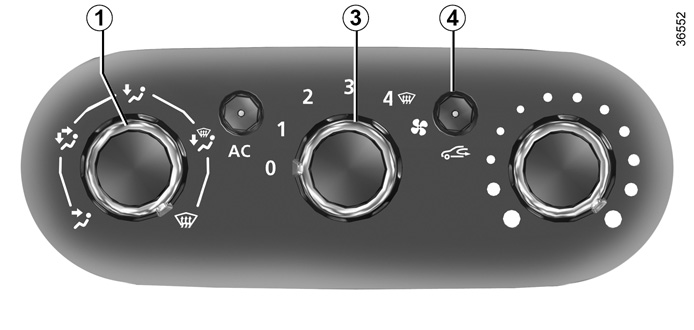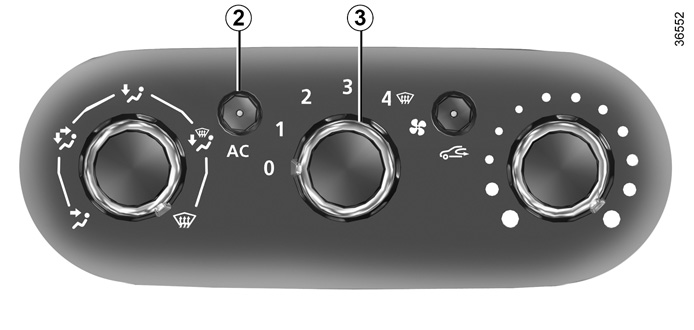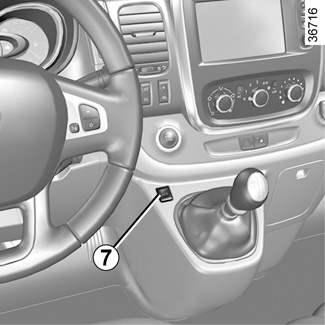MANUAL AIR CONDITIONING

Controls
The controls will depend on the vehicle equipment level.
1 Distribution of air.
2 Switching air conditioning on or off.
3 Adjusting the ventilation fan speed.
4 Switching passenger compartment isolation mode/air recirculation mode on
5 Air temperature adjuster.
Information and advice on use: refer to information on “Air conditioning: information and advice on use”.
Adjusting the air temperature
Turn control 5 to obtain the desired temperature. The further towards the red the slide is, the higher the temperature will be.
Adjusting the ventilation fan speed
Turn control 3 from 0 to 4. The further to the right it is positioned, the more air is blown into the passenger compartment. If you want to shut off the flow of air, set control 3 to 0.
The system is deactivated: the ventilation speed for the passenger compartment air is zero (vehicle stationary), you can however still feel a slight flow of air when the vehicle is moving.
Note
Leaving this control in position 0 for prolonged periods can lead to condensation forming on the side windows and windscreen and problems due to the use of non-renewed air in the passenger compartment.
Rapid demisting
Isolation of the passenger compartment/air recirculation deactivated (warning light integrated in button 4 is off), put controls 1 and 3 to W positions.
Using the climate control increases the speed of demisting.

Switching passenger compartment isolation mode/air recirculation mode on.
Press button 4 (the warning light comes on).
Under these conditions, air is taken from the passenger compartment and is recirculated, with no air being taken from outside the vehicle.
Air recirculation is used to:
- to isolate the passenger compartment from the external atmosphere (e.g. driving in polluted areas, etc.);
- to bring the passenger compartment to the desired temperature as quickly as possible.

Rear screen de-icing/demisting
With the engine running, press switch 6. The integrated indicator light comes on.
This function permits rapid demisting/de-icing of the rear screen and de-icing of the door mirrors (on equipped vehicles).
To exit the function, press switch 6 again.
Demisting automatically stops.
Prolonged use of air recirculation can lead to condensation forming on the side windows and windscreen, and discomfort due to the use of non-renewed air in the passenger compartment. We therefore advise you to return to normal mode (external air) as soon as the air recirculation function is no longer required, by pressing the button 4 again.

Distribution of air in the passenger compartment
Turn control 1 to choose the distribution option.
J All the air flow is directed to the dashboard vents.
G The air flow is directed towards the dashboard vents and the footwells.
F The air flow is mainly distributed between the front and rear footwells and the dashboard vents.
Close the dashboard vents to direct all the air to the foot wells.
i The air flow is distributed between all the air vents, the front side window demisting air vents, the windscreen demisting vents and the footwells.
W All the air is then directed to the windscreen and front side window demisting vents.

Switching air conditioning on or off
The air conditioning is switched on (indicator light illuminated) or off (indicator light extinguished) using button 2.
Activation is not possible if control 3 is set to 0.
The air conditioning system is used for:
- lower the temperature inside the passenger compartment;
- eliminate condensation more quickly.
The air conditioning does not operate when the exterior temperature is low.
Do not open the refrigerant fluid circuit. The fluid may damage eyes or skin.

Vehicles fitted with the ECO mode (button 7): Once activated, ECO mode may reduce the effective performance of the heating and/or air conditioning. Please refer to the information on “Driving advice, Eco-driving” in Section 2.